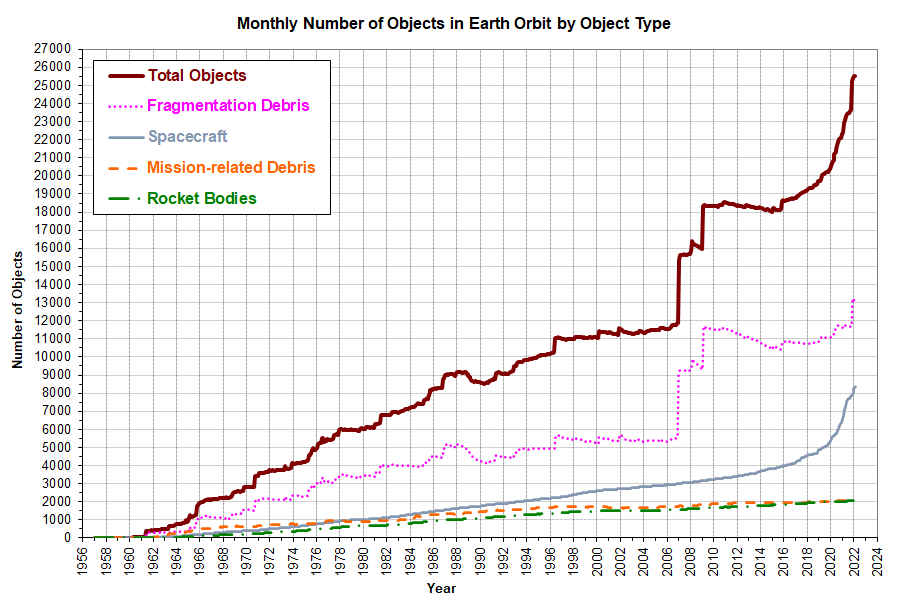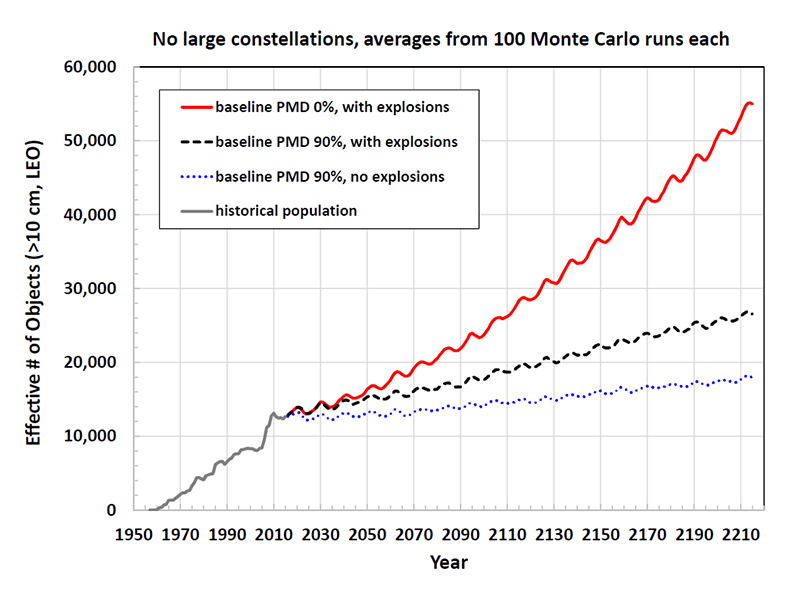LEGEND : 3D/OD Evolutionary Model
LEGEND is a full-scale, three-dimensional, debris evolutionary model that is the NASA Orbital
Debris Program Office’s primary model for study of the long-term debris environment projection.
It covers the near-Earth space between 200 and 50,000 km altitude, including low Earth orbit
(LEO), medium Earth orbit (MEO), and geosynchronous orbit (GEO) regions.
The model provides debris characteristics (number, type, orbital elements, etc.) as functions of
time, altitude, longitude, and latitude. In addition, LEGEND includes both historical simulation
and future projection components. Populations included in the model are active and spent spacecraft,
rocket bodies, breakup fragments, and mission-related debris, making it possible for the minimum
size (diameter) threshold in the model to be as small as 1 mm.

Chart showing number of objects >10 cm in LEO. Credit: NASA ODPO.
The main function of the LEGEND historical component is to reproduce the historical debris environment
(1957 to the present) to validate the techniques used for the future projection component of the model.
The model uses a recently updated historical satellite launch database (DBS database), two efficient
state-of-the-art propagators (PROP3D and GEOPROP), and the NASA Standard Breakup Model.
Both the overall program structure and the input and output options are optimized to allow reasonable
execution time and manageable file storage and memory space. The program is capable of providing
multi-dimensional descriptions of the debris environment based on user-specified scenarios, while
additional modules have been developed to better analyze and visualize the model outputs.

LEGEND-simulated historical LEO environment and results from three different future projection scenarios. Each projection curve is the average of 100 MC runs. The effective number is defined as the fractional time, per orbital period, an object spends between 200 km and 2000 km altitudes. Credit: NASA ODPO.
The main function of the LEGEND future projection component is to provide an understanding of how the
orbital debris environment evolves in the future. It is also a reliable tool to examine how various
mitigation practices may help protect the environment. A key element in the LEGEND future projection
component is a three-dimensional evaluation model that provides a fast and accurate way to estimate
future on-orbit collisions from LEO to GEO. Since no assumptions regarding the right ascensions of the
ascending node and arguments of perigee of objects involved are required, this probability model captures
the collision characteristics in real three-dimensional physical space. It is a critical component of a true
three-dimensional debris evolutionary model.
The typical projection period in LEGEND is 200 years. Due to uncertainties involved in the process
(e.g., future launch traffic, solar activity, explosions, collisions), conclusions are usually drawn
based on averaged results from 100 or more Monte Carlo simulations. The main program and subroutines
of LEGEND are written in standard FORTRAN 90 language. Additional analysis tools are written in FORTRAN
90 and MATLAB.